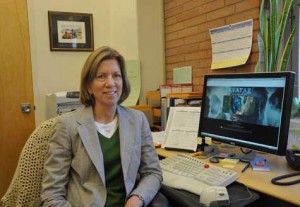While you may have been distracted by the whir of Navi flyers or distraught by a translucent plotline or even nauseated by your 3-D glasses, chances are if you saw James Cameron’s Avatar last year, you spent very little time focused on its plant life.
Yet there is one unnamed Pandora player whose contributions, touted recently by the theatrical run of Avatar‘s special edition release, whose entire 15 minutes of Hollywood acclaim came because of those fronds.
A professor of plant physiology and former chair of the department of botany and plant sciences at the University of California, Riverside, Jodie Holt was asked to be a botanical consultant for Avatar. In 2007, she directed actress Sigourney Weaver on how a botanist dressed, acted and approached plants, and later engaged in a series of advisory communications with Avatar‘s set designer on botany equipment for the film.
In the fall of 2008, Holt was asked to create a number of Wikipedia-like entries for the film’s suite of video game products. “The plants were surprisingly credible,” Holt remarked, following that statement with some academic grains of salt. “[But] I’m really proud that a 14-year-old playing a video game will [learn something] about plant life.”
Still, there’s more to Holt than the sensorial feast she helped to create for Avatar. Holt has made great strides in the study of weedy and invasive plant species.
As industrial development moves at a breakneck pace, some plants are inadvertently relocated to sites not used to hosting them. The expansion of these now new species can occur rapidly, with newer plants taking over territory at the expense of their native counterparts. “From the very beginning, the thing I’ve been most interested in is the plants’ interaction with their environment,” said Holt, adding, “Weeds are plants out of place.”

In the first part of her career, Holt focused on weed growth in agriculture, coauthoring the book, Ecology of Weeds and Invasive Plants: Relationship to Agriculture and Natural Resource Management.
This book discussed weed and invasive plant development, as well as ecologically sound weeding of exotic species.
Holt’s research has since evolved to study invasive species in wild areas where commercial weeding practices are not viable. The challenge in eliminating invasive species from these environments comes not only in classifying invasive species, as some exotic plants have been around for generations, but also in extracting weeds without harming endangered plants and animals.
“You can’t just grab a spray in the wildlands,” Holt said. “It becomes a matter of elimination with plows and bush rakes.”
Much of Holt’s current work surrounds invasive species in riparian environments: studying conditions that establish growth, repress growth and prevent reinvasion. Holt is particularly interested in the giant reed or arundo, an Asian native that flourishes along the western coast of the United States.
“As with all the sciences,” Holt said, the study of invasive species often lacks the money to manage invaders in remote areas or to pay for research staff — “especially when the work is not important to the masses.”
But getting word to the masses, she believes, is important for scientists. “You have to learn how to be approachable. There used to be a real divide between researchers in their lab coats and glasses to now. [Scientists now] all have branches that deal with outreach. It’s an essential function in science today.”
For her part, Holt has woven education and outreach into her study. A fellow of both the American Association for the Advancement of Science and the Weed Science Society of America, she has served as an associate editor of the journal Invasive Plant Science and Management, and she was honored in the 2008-09 academic year with UCR’s Distinguished Teaching Award. Earlier this month, the San Diego Botanic Gardens presented her with the Paul Ecke Jr. Award of Excellence.
This award was established by the San Diego Botanic Garden in 2002 and recognizes exceptional achievements by an individual or group for contributions made in education, conservation, creation of preservation of public spaces and preservation or re-creation of historically significant plantings and structures.





